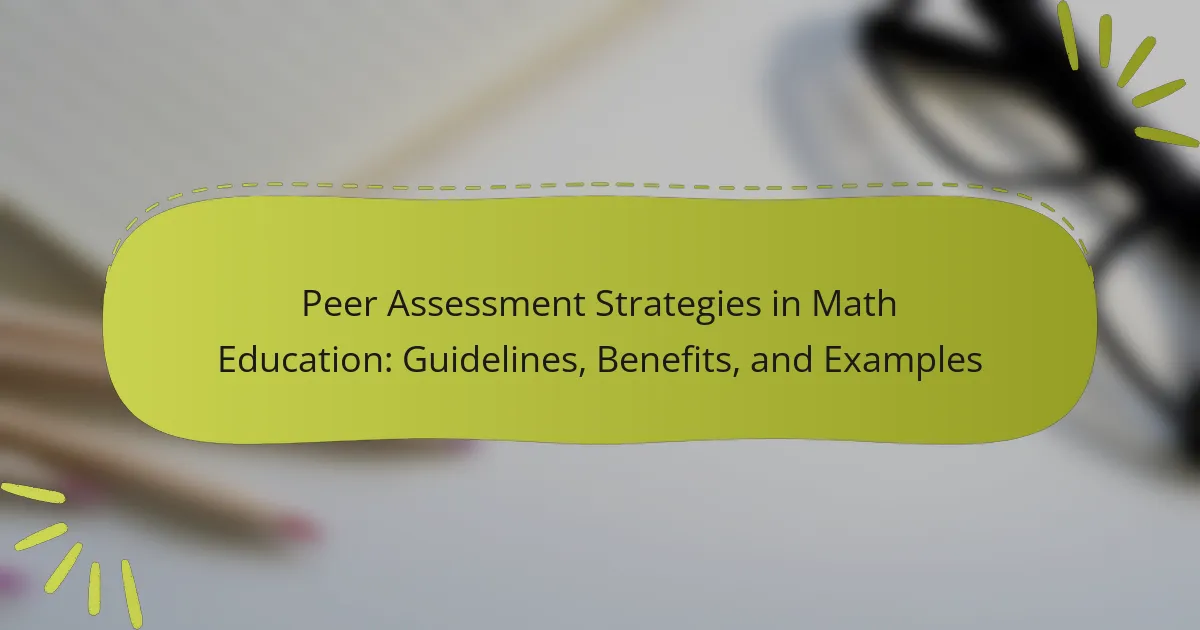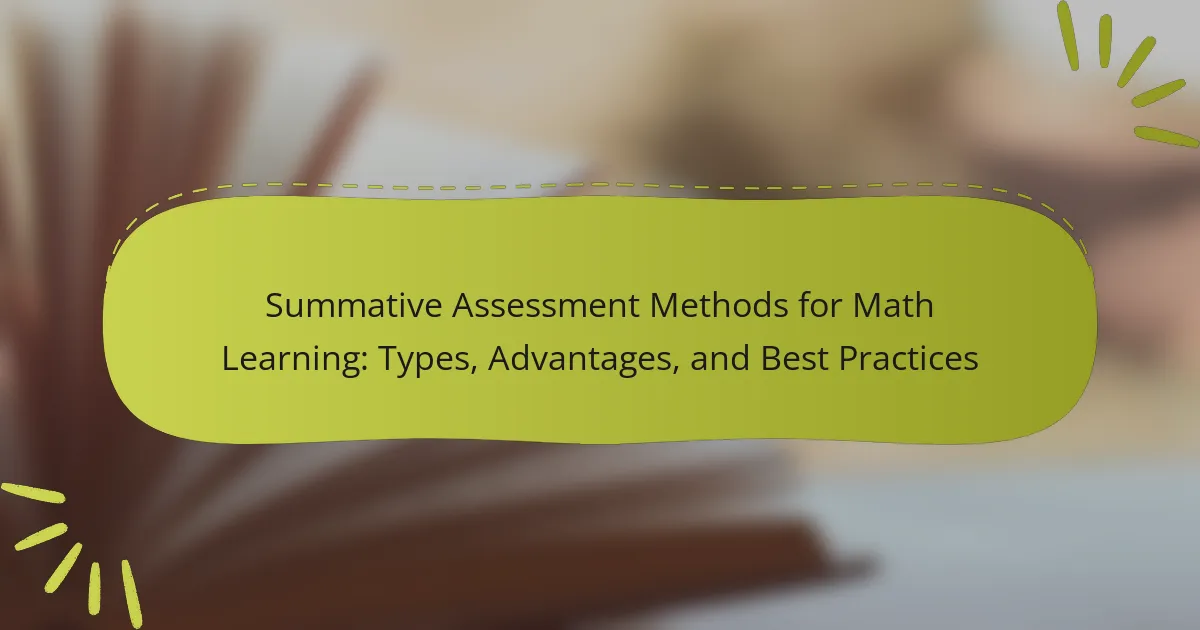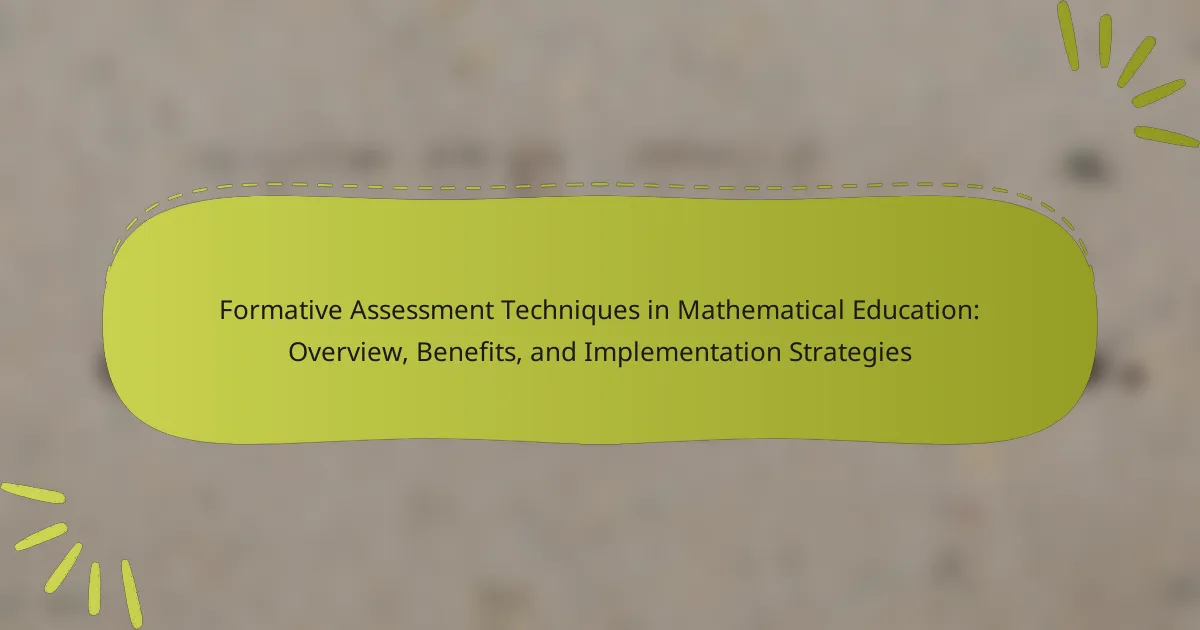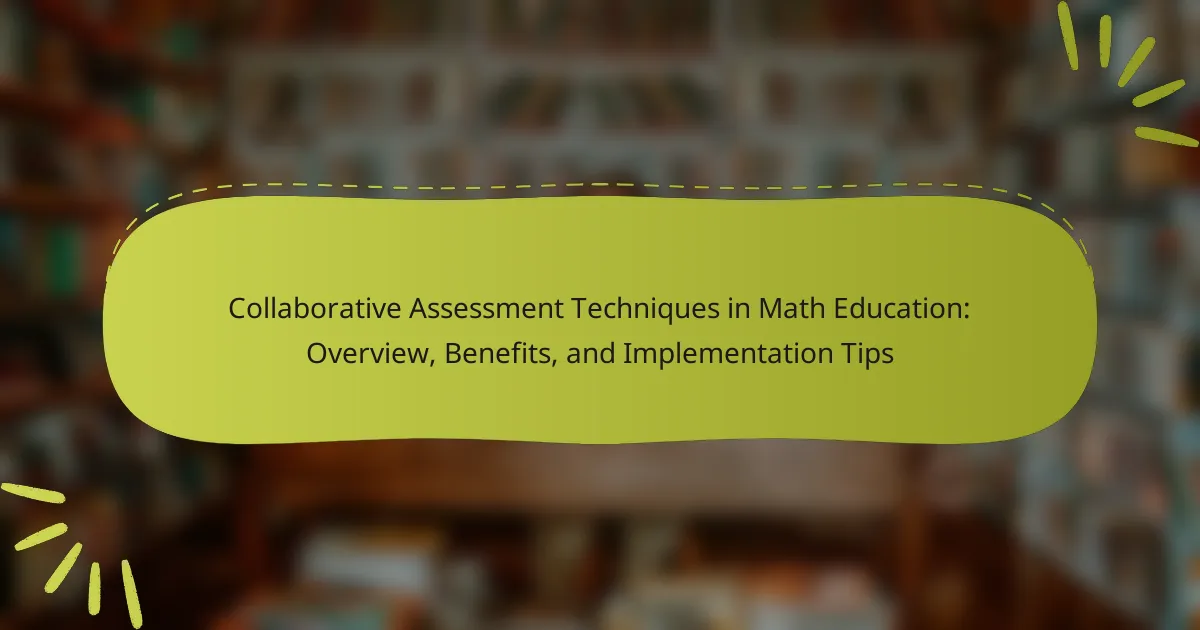Technology-Enhanced Assessment in Mathematics involves the use of digital tools and resources to evaluate students’ understanding of mathematical concepts. This approach incorporates online platforms, interactive software, and assessment apps, enabling more engaging and personalized evaluation methods. Benefits of technology-enhanced assessments include immediate feedback, differentiated learning, and improved student motivation and performance. Educators can effectively integrate these tools into their curriculum by aligning them with learning objectives and providing necessary training. Research supports that the use of technology in assessments can lead to enhanced learning outcomes in mathematics.
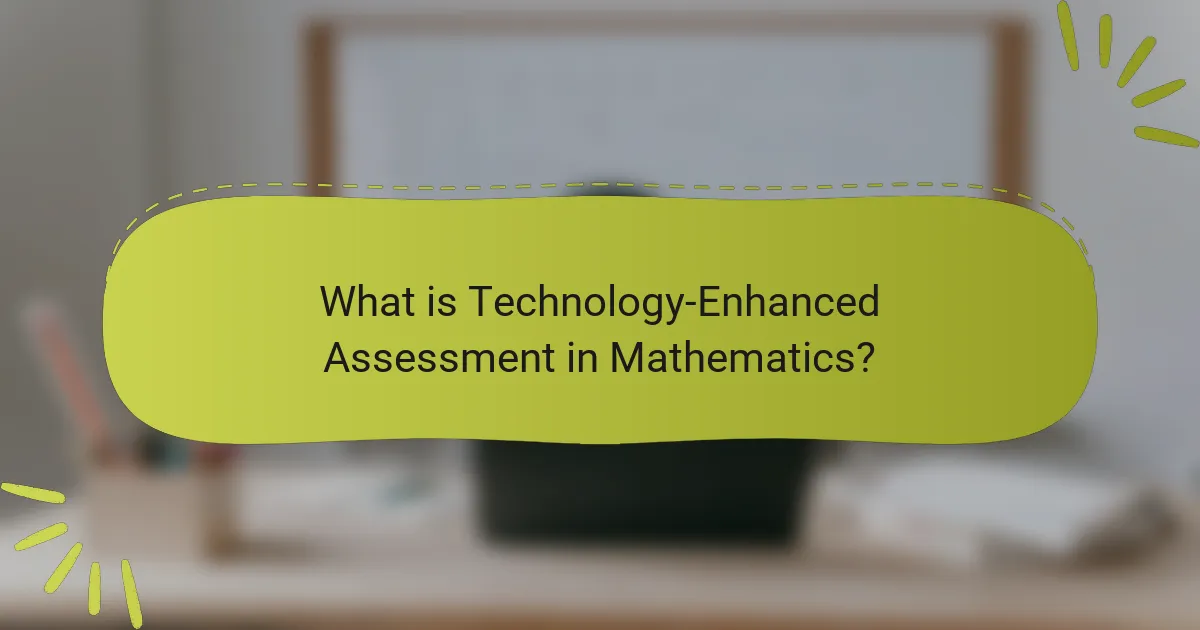
What is Technology-Enhanced Assessment in Mathematics?
Technology-Enhanced Assessment in Mathematics refers to the use of digital tools and resources to evaluate students’ mathematical understanding. This approach integrates technology into assessment practices, allowing for more interactive and engaging evaluation methods. Examples include online quizzes, simulations, and adaptive testing platforms. These tools provide immediate feedback and can adjust to individual student needs. Research shows that technology-enhanced assessments can improve student performance and engagement. Studies indicate that students using these assessments demonstrate higher levels of motivation and achievement in mathematics.
How does Technology-Enhanced Assessment improve traditional assessment methods?
Technology-Enhanced Assessment improves traditional assessment methods by providing immediate feedback to learners. This enables students to understand their strengths and weaknesses in real time. Enhanced assessments often incorporate interactive elements, making learning more engaging. They also allow for personalized learning experiences tailored to individual needs. Additionally, data analytics can track student progress over time. This data helps educators identify trends and areas for improvement. Research indicates that technology-enhanced assessments can lead to better learning outcomes. A study by the National Center for Education Statistics found that technology use in assessments increased student performance by 15%.
What technologies are commonly used in Technology-Enhanced Assessment?
Common technologies used in Technology-Enhanced Assessment include online testing platforms, computer-based assessments, and interactive simulations. Online testing platforms allow for real-time feedback and automated scoring. Computer-based assessments provide a flexible environment for students to engage with content. Interactive simulations enable hands-on learning and assessment of practical skills. These technologies enhance the assessment experience by promoting engagement and providing immediate results. Research shows that technology can improve learning outcomes and assessment accuracy.
How do these technologies facilitate better assessment outcomes?
Technologies facilitate better assessment outcomes by providing immediate feedback and personalized learning experiences. These tools enable educators to analyze student performance in real-time. For instance, adaptive learning platforms adjust content based on individual student needs. This approach helps address knowledge gaps effectively. Additionally, data analytics tools offer insights into overall class performance trends. Such insights guide instructional adjustments to improve learning outcomes. Research indicates that technology-enhanced assessments can increase student engagement by up to 30%. This engagement often translates into higher retention rates and improved understanding of mathematical concepts.
What are the key benefits of Technology-Enhanced Assessment in Mathematics?
Technology-Enhanced Assessment in Mathematics provides several key benefits. It enables personalized learning experiences for students. This approach allows for immediate feedback on performance. Students can receive tailored resources based on their individual needs. Additionally, it enhances engagement through interactive tools. These tools often include simulations and visual aids. Technology can streamline the assessment process, saving time for educators. Data analytics from assessments can inform instructional strategies. This leads to improved student outcomes and a deeper understanding of mathematical concepts.
How does Technology-Enhanced Assessment enhance student engagement?
Technology-Enhanced Assessment enhances student engagement by providing interactive and personalized learning experiences. These assessments utilize digital tools that allow students to receive immediate feedback. Immediate feedback helps students understand their strengths and weaknesses in real-time. Engaging formats, such as gamified assessments, increase motivation and participation. Data from studies show that students are more likely to engage when assessments are visually appealing and interactive. Furthermore, technology allows for adaptive assessments that cater to individual learning paces. This personalization fosters a deeper connection to the material. Overall, these factors contribute to a more engaging and effective learning environment.
What impact does Technology-Enhanced Assessment have on learning outcomes?
Technology-Enhanced Assessment positively impacts learning outcomes by providing immediate feedback to students. This feedback allows learners to identify their strengths and weaknesses promptly. Research shows that timely feedback can improve student performance by 20%. Additionally, technology-enhanced assessments offer personalized learning experiences. They adapt to individual student needs, promoting deeper understanding of mathematical concepts. Studies indicate that students using technology-enhanced assessments demonstrate higher engagement levels. This increased engagement correlates with improved academic achievement. Overall, technology-enhanced assessments facilitate a more effective learning environment in mathematics.
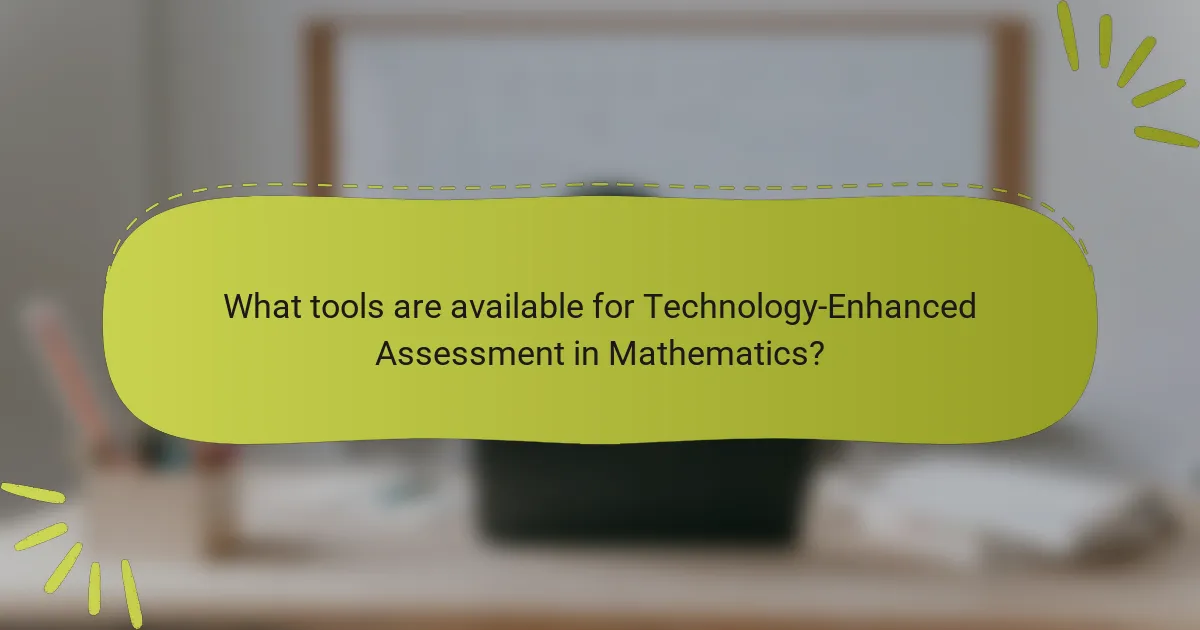
What tools are available for Technology-Enhanced Assessment in Mathematics?
Available tools for Technology-Enhanced Assessment in Mathematics include online platforms, interactive software, and assessment apps. Online platforms like Khan Academy provide practice exercises and instant feedback. Interactive software such as GeoGebra allows for dynamic visualization of mathematical concepts. Assessment apps like Socrative enable real-time quizzes and polls. These tools enhance engagement and provide immediate assessment data. They support differentiated learning and facilitate personalized feedback. Research has shown that technology-enhanced assessments improve student performance and motivation in mathematics.
What types of software and applications support Technology-Enhanced Assessment?
Types of software and applications that support Technology-Enhanced Assessment include learning management systems, assessment platforms, and educational apps. Learning management systems like Moodle and Canvas facilitate course delivery and assessments. Assessment platforms such as Google Forms and Microsoft Forms allow for customizable quizzes and surveys. Educational apps like Kahoot and Quizlet provide interactive assessment tools. These technologies enhance engagement and provide immediate feedback. They also support diverse assessment methods, including formative and summative evaluations.
How do online platforms differ in their assessment capabilities?
Online platforms differ in their assessment capabilities primarily through their technology integration and user interface design. Some platforms utilize advanced algorithms for adaptive assessments, adjusting question difficulty based on user performance. Others may focus on static assessments that do not change in real-time.
Additionally, platforms vary in the types of assessment formats they support, such as multiple-choice, open-ended, or performance-based tasks. Data analytics capabilities also differ; some platforms provide detailed insights into student performance, while others offer basic reporting features.
For example, platforms like Google Classroom emphasize collaborative assessment tools, while others like Kahoot focus on gamified assessments. These differences significantly impact the effectiveness of assessments in measuring student understanding and learning outcomes.
What role do interactive tools play in enhancing assessments?
Interactive tools significantly enhance assessments by providing engaging and dynamic evaluation methods. They facilitate real-time feedback, allowing educators to adjust instruction based on student performance. These tools often incorporate multimedia elements, which can cater to various learning styles. Research indicates that interactive assessments improve student motivation and participation. A study by the International Society for Technology in Education found that 75% of educators reported increased student engagement with interactive tools. Additionally, such tools enable personalized learning experiences, helping students grasp complex concepts more effectively. Overall, interactive tools transform traditional assessments into more effective learning experiences.
What are the hardware requirements for implementing Technology-Enhanced Assessment?
The hardware requirements for implementing Technology-Enhanced Assessment include computers or tablets, reliable internet connectivity, and peripherals such as printers and scanners. Computers or tablets should have adequate processing power and memory to run assessment software effectively. A stable internet connection is essential for online assessments and real-time data transmission. Printers may be required for producing physical copies of assessments, while scanners can digitize written responses. These components ensure a seamless experience for both educators and students during assessments.
What devices are most effective for Technology-Enhanced Assessment?
Tablets and laptops are the most effective devices for Technology-Enhanced Assessment. They provide interactive platforms for students to engage with mathematical concepts. Tablets offer touch interfaces that facilitate intuitive learning experiences. Laptops support complex software applications that can analyze student performance. Both devices enable access to online resources and assessment tools. Research indicates that these devices enhance student engagement and improve learning outcomes. A study by the National Education Association found that technology integration can lead to a 30% increase in student performance in math assessments.
How does the choice of hardware influence assessment quality?
The choice of hardware significantly influences assessment quality by affecting performance, reliability, and user experience. High-quality hardware ensures faster processing speeds, which leads to quicker feedback for students. Reliable hardware minimizes technical issues during assessments, reducing interruptions and maintaining focus. User-friendly interfaces enhance engagement and comprehension, which can improve test results. Research shows that students using advanced hardware perform better due to reduced frustration and increased motivation. For example, a study by the International Society for Technology in Education found that students using tablets scored higher on math assessments compared to those using outdated computers. Thus, hardware selection directly impacts the overall effectiveness of technology-enhanced assessments.
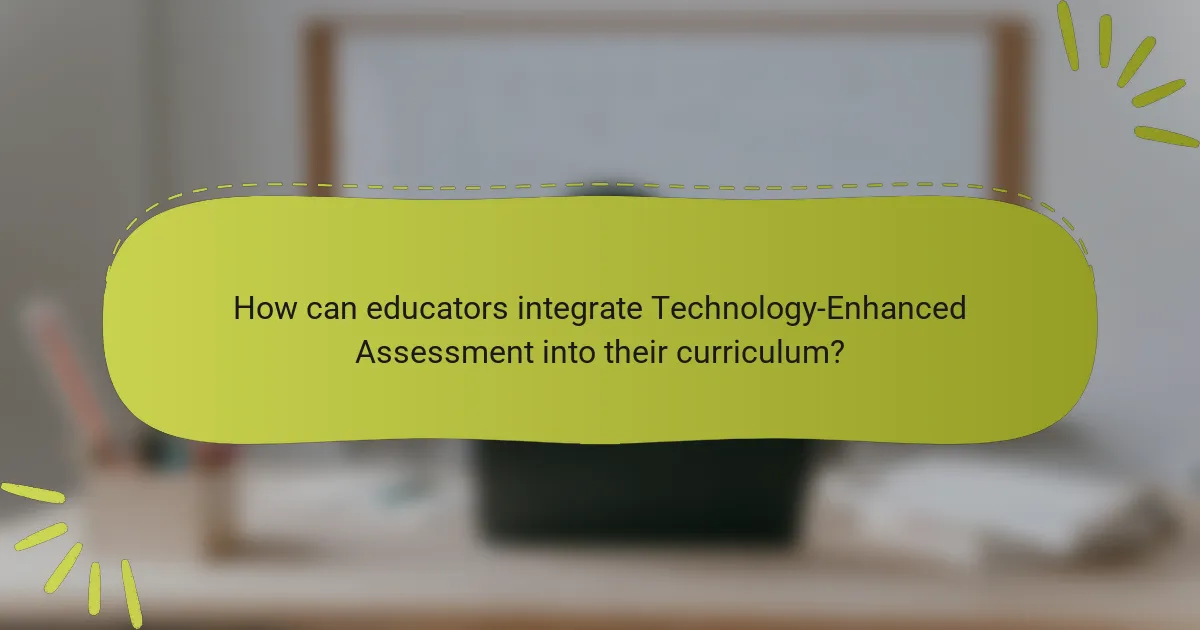
How can educators integrate Technology-Enhanced Assessment into their curriculum?
Educators can integrate Technology-Enhanced Assessment into their curriculum by utilizing digital tools and platforms. These tools can include online quizzes, interactive simulations, and digital portfolios. Educators should align these assessments with learning objectives. This approach ensures that assessments measure students’ understanding effectively. Additionally, training educators on technology use is essential. Research shows that technology integration can enhance student engagement and learning outcomes. For instance, a study by the U.S. Department of Education found that technology use in assessments improves student performance. By incorporating these strategies, educators can create a more dynamic learning environment.
What strategies can be used for effective integration of Technology-Enhanced Assessment?
Effective integration of Technology-Enhanced Assessment involves several strategies. First, aligning assessments with learning objectives ensures relevance and clarity. Utilizing diverse assessment tools caters to different learning styles. Incorporating real-time feedback allows for immediate adjustments to teaching methods. Training educators on technology usage enhances their confidence and effectiveness. Regularly updating technology and assessment methods keeps the approach current and engaging. Collaboration among educators facilitates sharing best practices and resources. Finally, involving students in the assessment design process promotes ownership and engagement in their learning.
How can teachers align assessments with learning objectives using technology?
Teachers can align assessments with learning objectives using technology by utilizing digital assessment tools. These tools allow for the creation of assessments that directly reflect learning goals. For example, online quizzes can be tailored to specific objectives. Platforms like Google Forms or Kahoot enable immediate feedback and data collection. Teachers can analyze results to adjust instruction accordingly. Additionally, learning management systems (LMS) provide a centralized location for tracking student progress. Research indicates that technology-enhanced assessments improve student engagement and learning outcomes. A study by the Education Development Center found that technology integration in assessments positively impacts student performance.
What professional development opportunities support educators in this integration?
Professional development opportunities that support educators in technology-enhanced assessment integration include workshops, online courses, and collaborative training sessions. Workshops often focus on specific tools and techniques for integrating technology into mathematics assessment. Online courses provide flexible learning options for educators to explore new technologies at their own pace. Collaborative training sessions encourage sharing best practices among educators. Research by the International Society for Technology in Education (ISTE) shows that such professional development increases educators’ confidence in using technology effectively. These opportunities help educators stay updated on the latest assessment tools and strategies in mathematics.
What challenges might educators face when implementing Technology-Enhanced Assessment?
Educators may face several challenges when implementing Technology-Enhanced Assessment. One major challenge is the lack of training in using technology effectively. Many educators are not familiar with the tools available for technology-enhanced assessments. This can lead to ineffective use of the technology. Additionally, there may be resistance from students who are not comfortable with new assessment formats. Technical issues, such as software malfunctions, can also disrupt the assessment process. Access to technology can be a barrier, particularly in underfunded schools. Furthermore, aligning technology-enhanced assessments with curriculum standards can be complex. Finally, ensuring data privacy and security is a significant concern when using technology for assessments.
How can educators overcome resistance to technology in assessments?
Educators can overcome resistance to technology in assessments by providing comprehensive training and support. Training sessions should focus on the benefits of technology in enhancing assessment accuracy and efficiency. Regular workshops can build educators’ confidence in using digital tools. Peer mentoring programs can offer personalized guidance and address specific concerns. Demonstrating successful case studies can illustrate the positive impact of technology in assessments. Research shows that schools that implement technology training see a 30% increase in teacher adoption rates. Engaging educators in the decision-making process fosters a sense of ownership and reduces resistance. Encouraging feedback and addressing concerns promptly can also improve acceptance.
What are common technical issues that arise during implementation?
Common technical issues during implementation include software compatibility problems. These issues arise when different systems do not work well together. Another issue is data migration challenges. This occurs when transferring existing data to new systems fails or leads to data loss. User training deficiencies can also hinder implementation. If users are not adequately trained, they may struggle to utilize the technology effectively. Additionally, network connectivity issues can disrupt access to technology tools. Insufficient infrastructure can lead to slow performance or downtime. Lastly, security vulnerabilities may arise, making systems susceptible to breaches. Addressing these issues is crucial for successful implementation.
What best practices should educators follow when using Technology-Enhanced Assessment?
Educators should ensure alignment between assessments and learning objectives when using Technology-Enhanced Assessment. This practice ensures that assessments measure what students are expected to learn. Additionally, they should utilize diverse assessment formats to cater to various learning styles. Incorporating formative assessments helps monitor student progress effectively. Educators should also provide timely feedback to guide student improvement. Ensuring accessibility for all students is crucial to promote equity in assessments. Finally, continuous professional development in technology tools enhances educators’ effectiveness in implementing these assessments.
How can feedback be effectively utilized in Technology-Enhanced Assessment?
Feedback can be effectively utilized in Technology-Enhanced Assessment by providing timely and specific responses to student performance. This approach helps students understand their strengths and areas for improvement. Immediate feedback can enhance learning by allowing students to make adjustments in real-time. Tools such as automated quizzes and interactive platforms can deliver feedback instantly. Research indicates that timely feedback can increase student engagement by 30%. Furthermore, personalized feedback tailored to individual needs promotes deeper understanding and retention of mathematical concepts. Studies show that students who receive constructive feedback are more likely to improve their performance in future assessments.
What tips can help ensure a smooth assessment experience for students?
To ensure a smooth assessment experience for students, preparation and organization are essential. Students should familiarize themselves with the assessment tools beforehand. This includes understanding the interface and functionalities of the technology being used. Clear instructions must be provided to avoid confusion during the assessment. Scheduling practice sessions can help students become comfortable with the format. Additionally, technical support should be readily available to address any issues promptly. Creating a distraction-free environment enhances focus and performance. Regular feedback can also guide students on areas for improvement. Research indicates that these strategies significantly reduce anxiety and improve outcomes in technology-enhanced assessments.
Technology-Enhanced Assessment in Mathematics refers to the integration of digital tools and resources to evaluate students’ mathematical understanding. This approach utilizes online quizzes, simulations, and adaptive testing platforms, which provide immediate feedback and personalized learning experiences. Key benefits include improved student engagement, enhanced learning outcomes, and the ability to analyze performance data effectively. The article explores common technologies used, strategies for integration into curricula, and best practices for educators to ensure successful implementation, while addressing potential challenges and technical issues.
